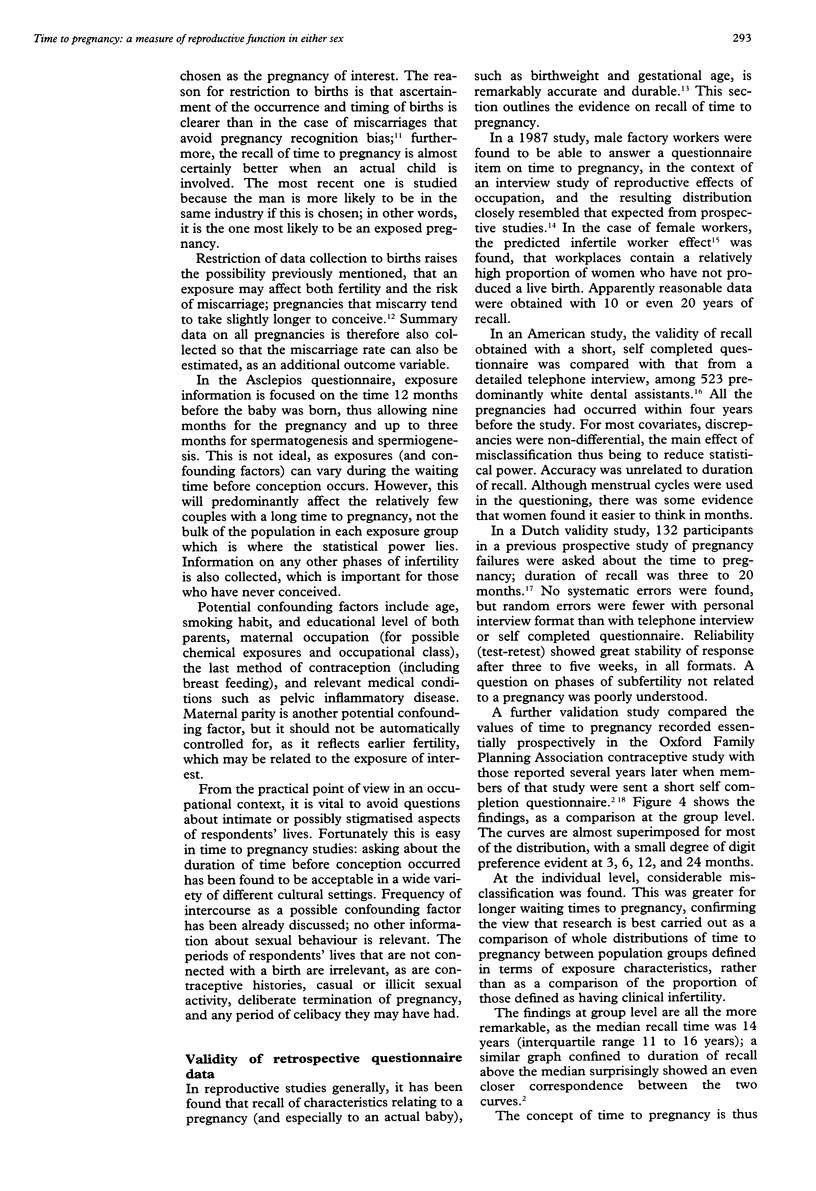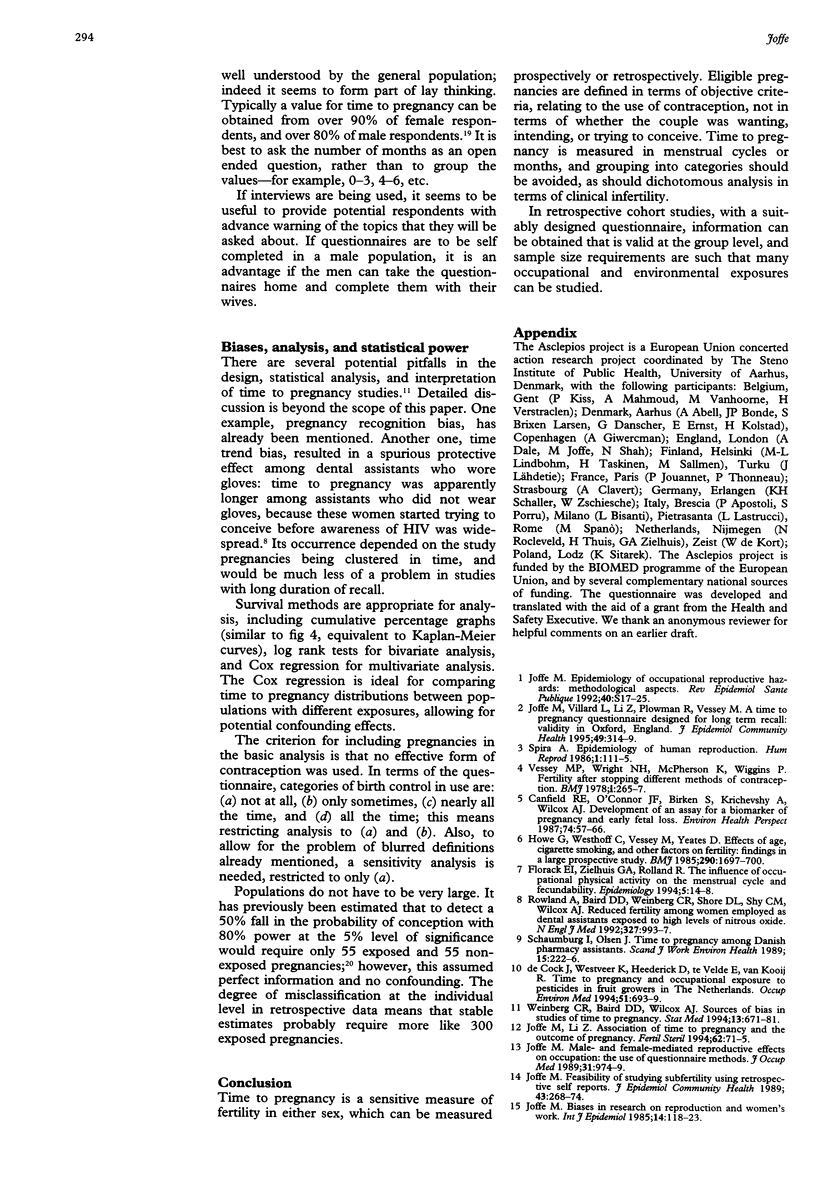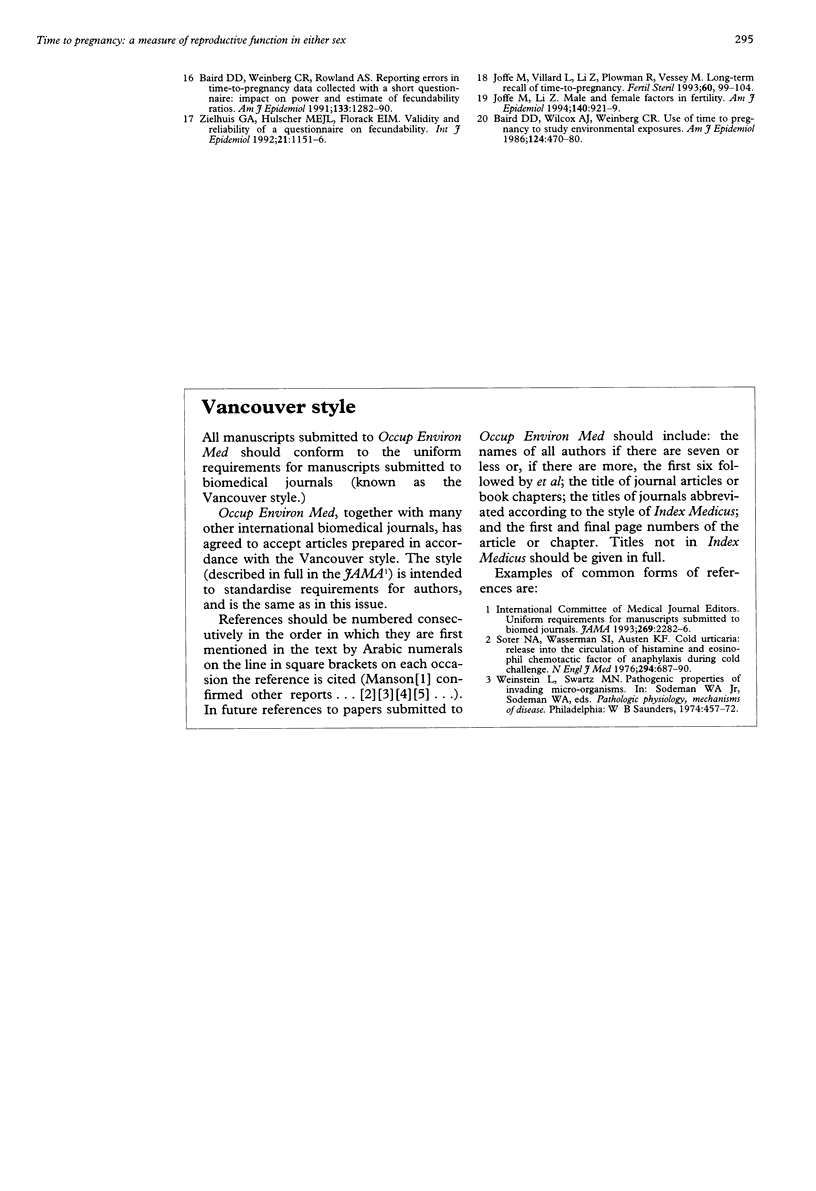Abstract
INTRODUCTION: Growing evidence of reproductive effects associated with occupational and environmental agents has created the need for research with sensitive and well validated methods. There is a complex relation between manifest effects and underlying pathogenic processes. Conceptions will on average tend to be delayed in a population exposed to an agent that causes embryonic damage, an increase in germ cell mutations, or decreased fertility. STUDYING TIME TO PREGNANCY: Time to pregnancy can be used to measure the degree of delay in conceiving, across the whole continuum of biological fertility, in either men or women. The distribution of time to pregnancy largely reflects a sorting process, as the more fertile couples become progressively less well represented with the passage of time. The basic research strategy is comparison of the time to pregnancy within groups defined by their exposures, allowing for potential confounding factors relating not only to the study subject but also to his or her partner. MEASUREMENT AND VALIDITY: Prospective and retrospective methods are available, and each has strengths and weaknesses. Prospective studies have some theoretical advantages, but have unrepresentative populations and problems of feasibility and cost. Retrospective assessment of time to pregnancy is feasible with a short questionnaire, without intruding into sensitive areas of respondents' lives, with good validity at the group level, and without the necessity of large populations. Potential biases have been identified that can be minimised by careful design and analysis; the principal remaining problem is difficulty in obtaining exposure data retrospectively.
Full text
PDF






Selected References
These references are in PubMed. This may not be the complete list of references from this article.
- Baird D. D., Wilcox A. J., Weinberg C. R. Use of time to pregnancy to study environmental exposures. Am J Epidemiol. 1986 Sep;124(3):470–480. doi: 10.1093/oxfordjournals.aje.a114417. [DOI] [PubMed] [Google Scholar]
- Canfield R. E., O'Connor J. F., Birken S., Krichevsky A., Wilcox A. J. Development of an assay for a biomarker of pregnancy and early fetal loss. Environ Health Perspect. 1987 Oct;74:57–66. doi: 10.1289/ehp.877457. [DOI] [PMC free article] [PubMed] [Google Scholar]
- Florack E. I., Zielhuis G. A., Rolland R. The influence of occupational physical activity on the menstrual cycle and fecundability. Epidemiology. 1994 Jan;5(1):14–18. doi: 10.1097/00001648-199401000-00004. [DOI] [PubMed] [Google Scholar]
- Howe G., Westhoff C., Vessey M., Yeates D. Effects of age, cigarette smoking, and other factors on fertility: findings in a large prospective study. Br Med J (Clin Res Ed) 1985 Jun 8;290(6483):1697–1700. doi: 10.1136/bmj.290.6483.1697. [DOI] [PMC free article] [PubMed] [Google Scholar]
- Joffe M. Biases in research on reproduction and women's work. Int J Epidemiol. 1985 Mar;14(1):118–123. doi: 10.1093/ije/14.1.118. [DOI] [PubMed] [Google Scholar]
- Joffe M. Epidemiology of occupational reproductive hazards: methodological aspects. Rev Epidemiol Sante Publique. 1992;40 (Suppl 1):S17–S25. [PubMed] [Google Scholar]
- Joffe M. Feasibility of studying subfertility using retrospective self reports. J Epidemiol Community Health. 1989 Sep;43(3):268–274. doi: 10.1136/jech.43.3.268. [DOI] [PMC free article] [PubMed] [Google Scholar]
- Joffe M., Li Z. Association of time to pregnancy and the outcome of pregnancy. Fertil Steril. 1994 Jul;62(1):71–75. doi: 10.1016/s0015-0282(16)56818-6. [DOI] [PubMed] [Google Scholar]
- Joffe M., Li Z. Male and female factors in fertility. Am J Epidemiol. 1994 Nov 15;140(10):921–929. doi: 10.1093/oxfordjournals.aje.a117180. [DOI] [PubMed] [Google Scholar]
- Joffe M. Male- and female-mediated reproductive effects of occupation: the use of questionnaire methods. J Occup Med. 1989 Dec;31(12):974–979. doi: 10.1097/00043764-198912000-00008. [DOI] [PubMed] [Google Scholar]
- Joffe M., Villard L., Li Z., Plowman R., Vessey M. A time to pregnancy questionnaire designed for long term recall: validity in Oxford, England. J Epidemiol Community Health. 1995 Jun;49(3):314–319. doi: 10.1136/jech.49.3.314. [DOI] [PMC free article] [PubMed] [Google Scholar]
- Joffe M., Villard L., Li Z., Plowman R., Vessey M. Long-term recall of time-to-pregnancy. Fertil Steril. 1993 Jul;60(1):99–104. doi: 10.1016/s0015-0282(16)56044-0. [DOI] [PubMed] [Google Scholar]
- Rowland A. S., Baird D. D., Weinberg C. R., Shore D. L., Shy C. M., Wilcox A. J. Reduced fertility among women employed as dental assistants exposed to high levels of nitrous oxide. N Engl J Med. 1992 Oct 1;327(14):993–997. doi: 10.1056/NEJM199210013271405. [DOI] [PubMed] [Google Scholar]
- Schaumburg I., Olsen J. Time to pregnancy among Danish pharmacy assistants. Scand J Work Environ Health. 1989 Jun;15(3):222–226. doi: 10.5271/sjweh.1859. [DOI] [PubMed] [Google Scholar]
- Spira A. Epidemiology of human reproduction. Hum Reprod. 1986 Feb;1(2):111–115. doi: 10.1093/oxfordjournals.humrep.a136353. [DOI] [PubMed] [Google Scholar]
- Vessey M. P., Wright N. H., McPherson K., Wiggins P. Fertility after stopping different methods of contraception. Br Med J. 1978 Feb 4;1(6108):265–267. doi: 10.1136/bmj.1.6108.265. [DOI] [PMC free article] [PubMed] [Google Scholar]
- Weinberg C. R., Baird D. D., Wilcox A. J. Sources of bias in studies of time to pregnancy. 1994 Mar 15-Apr 15Stat Med. 13(5-7):671–681. doi: 10.1002/sim.4780130528. [DOI] [PubMed] [Google Scholar]
- de Cock J., Westveer K., Heederik D., te Velde E., van Kooij R. Time to pregnancy and occupational exposure to pesticides in fruit growers in The Netherlands. Occup Environ Med. 1994 Oct;51(10):693–699. doi: 10.1136/oem.51.10.693. [DOI] [PMC free article] [PubMed] [Google Scholar]


